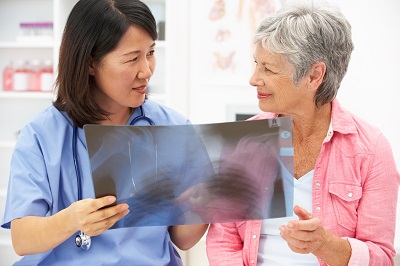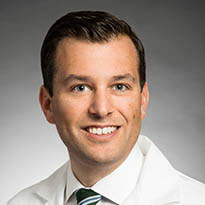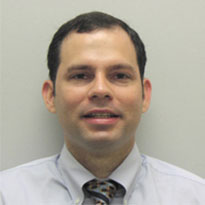What is Lung Cancer?

While this disease is certainly treatable, it can take a while for symptoms to develop and, therefore, may not be detected until it has spread to other parts of your body. This is why it’s so important for those at high risk (see criteria below) to be diligent about receiving regular lung cancer screenings.
What are the Two Most Common Types of Lung Cancer?
Non-Small Cell Lung Cancer
The majority of lung cancers – around 85% – are classified as non-small cell lung cancers (NSCLC). Most often developed in the outer portions of the lungs, non-small cell lung cancers typically are responsive to surgical treatment if detected early.
Small Cell Lung Cancer
Small cell lung cancer (SCLC) affects about 15% of all lung cancer patients and gets its name from its small, monotonous-looking cells that grow centrally in the lung, near the main air tubes. These cancer cells can spread quickly to the lymph nodes or areas outside of the chest, so this type of lung cancer is often considered more dangerous than non-small cell lung cancer.
Small cell lung cancer has the highest association with cigarette smoking and can affect both active and former smokers. Surgery is not normally recommended. Instead, your doctor may prescribe a combination of chemotherapy and radiation therapy to ensure all cancer cells are targeted.
Causes of Lung Cancer
According to the American Cancer Society, the majority of people diagnosed with lung cancer are 65 years of age or older. Unfortunately, 70% of those are diagnosed with late-stage lung cancer – providing even more reason for high-risk individuals to consider an annual lung cancer screening.
Not surprisingly, tobacco use is the leading cause of lung cancer, and smoking is responsible for 85 to 90% of all lung cancer diagnoses. Second-hand smoke can also increase your risk of lung cancer by as much as 30%.
Learn More About Tobacco Cessation
It is, however, possible to develop lung cancer even if you’ve never smoked. Adenocarcinoma, a form of non-small cell lung cancer, is the most common lung cancer found in nonsmokers and about 40% of all lung cancers are adenocarcinomas.
Exposure to certain toxic chemicals has also been known to cause lung cancer, including:
- Asbestos (may cause mesothelioma, a cancer of the outer lining of the lung)
- Radon gas
- Uranium
- Arsenic
- Coal products
What Are The Signs and Symptoms of Lung Cancer?
The symptoms listed below are not specific to lung cancer, but it’s important to notify your doctor as soon as you experience any, especially if they’re persistent.
- A cough that does not go away or gets worse
- Coughing up blood or rust-colored sputum (spit or phlegm)
- Chest pain that is often worse with deep breathing, coughing or laughing
- Hoarseness
- Weight loss and loss of appetite
- Shortness of breath
- Feeling tired or weak
- Infections such as bronchitis and pneumonia that don’t go away or keep coming back
- New onset of wheezing
Lung Cancer Prevention & Detection
Memorial Hermann Cancer Centers offer specialized Low-Dose CT (LDCT) screenings for lung cancer. Low-Dose Computed Tomography (LDCT) is an effective tool in screening for lung cancer and should be done before there are any symptoms. The goal of an LDCT lung screening is to save lives. Without this screening test, lung cancer is usually not found until a person develops symptoms.
Learn more about LDCT Screenings
Lung Cancer Risk Factors
- Tobacco use, including smoking cigarettes, cigars or pipes, now or in the past
- 90% of lung cancer patients are current or former smokers.
- Second-hand smoke exposure. Second-hand smoke exposure increases chances of developing lung cancer by 20 to 30%.
- Exposure to asbestos, arsenic, chromium, nickel or other substances in the workplace
- Exposure to radon, which can be found in the home as well as in the workplace
- Family history of lung cancer
How is Lung Cancer Diagnosed?
If you or a loved one has been diagnosed with lung cancer or if lung cancer is suspected, you’re likely feeling a range of emotions, not the least of which is a fear of the unknown. At Memorial Hermann, we understand this is a difficult time. That’s why we’re committed to offering you the highest level of lung cancer diagnostics and treatment in the Greater Houston area, in an environment focused on your comfort and healing.
In addition to physical exams and detailed medical histories, advances in medical technology now allow us to pinpoint suspicious masses in or around your lungs using diagnostic scans, called computed tomography (CT). If an abnormality is detected on the CT, a biopsy will be scheduled, a tissue sample will be examined by a pathologist and a diagnosis will be determined.
Lung Cancer Screenings for High-Risk Patients
Many lung cancers don’t cause noticeable symptoms until they have reached an advanced stage. And because early detection can drastically improve the chance of recovery, we strongly encourage annual lung cancer screenings for those at higher risk.
In 2014, Memorial Hermann introduced a screening process for high-risk patients who may not exhibit any symptoms. Using In 2014, Memorial Hermann introduced a screening process for high-risk patients who may not exhibit any symptoms. Using low-dose computed tomography (LDCT), we provide patients with annual lung cancer screenings to scan the lungs for hidden tumors, nodules, or other signs of cancer. (LDCT), we provide patients with annual lung cancer screenings to scan the lungs for hidden tumors, nodules, or other signs of cancer.
If you’re a current or former smoker and considered at higher risk of developing lung cancer (see criteria listed below), please consider what could be a life-saving screening.
Criteria for High-Risk Patients
According to the U.S. Preventive Services Task Force (USPSTF), a LDCT lung screening is recommended for people who are at high risk of lung cancer. Patients who are, or may be, at high risk fit the following criteria:
- Age 50-80
- Currently, or in the past, have a 20 pack-year smoking history, for 15 years
- A current smoker or one who has quit within the last 15 years
- Have no signs or symptoms of lung cancer
Health outcomes, benefits and risks are important for your physician to consider when recommending an LDCT lung screening. Not all people who smoke may fit the criteria necessary for screening. Your health care provider or a Lung Nurse Navigator can help you determine if you fit the criteria appropriate for receiving an LDCT lung screening.
To schedule a Lung Cancer Screening, contact one of our Oncology Nurse Navigators at (833) 770-7771 or fill out the form on this page to receive more information.
What are the Stages of Lung Cancer?
After diagnosis, your doctor will determine if lung cancer is contained within your lungs or has spread to any other parts of your body. This process is called staging. While no two people – and no two cancers – are the same, staging provides a guideline for doctors to develop the best course of treatment.
The stages are as follows:
- Stage I Lung Cancer: The tumor is confined to one lobe of the lung and has not spread to lymph nodes or areas outside the chest. Lung cancers caught in this stage have the highest chances of being cured.
- Stage II Lung Cancer: The tumor is larger or has spread to the lymph nodes in the chest.
- Stage III Lung Cancer: Similar to Stage II, with more lymph node involvement or a larger size of cancer. Generally, it is determined that surgery is not helpful in these cases, and a combination of chemotherapy and radiation therapy is normally prescribed.
- Stage IV Lung Cancer: The tumor has spread outside of the chest to the liver, bones or the adrenal glands above the kidneys. While there is treatment available for Stage IV lung cancer, it is generally not curative. However, chemotherapy and/or immunotherapy, along with supportive care, can extend traditional life expectancies for these patients.
Treatment Options for Lung Cancer
No matter your stage at diagnosis, Memorial Hermann is committed to providing you with the most advanced treatment options, tailored to your specific situation.
Those treatment options include but are not limited to:
- Thoracotomy: This surgery involves removing the lobe of the lung containing a tumor. In some cases, breathing tests will be conducted prior to surgery to determine if the patient can handle the loss of lung tissue. Surgical removal generally provides the best outcomes for early-stage lung cancers.
- Video-Assisted Thoracoscopic Surgery (VATS): Similar to a thoracotomy, VATS is a significantly less-invasive procedure. The surgeon inserts a small video camera into the chest cavity through a few small incisions, allowing them to conduct the tissue removal procedure with reduced chance of complications or infection. This treatment typically allows for a quicker recovery time.
- Stereotactic Body Radiation Therapy (SBRT): Sparing normal tissue, this is a form of external radiation therapy focused on the specific area where the tumor is located. Unlike traditional radiation therapy, SBRT involves four-to-five sequential treatments administered over the course of a week, with each treatment lasting only a few minutes.
- External Beam Radiation Therapy (EBRT): This is the most common form of radiation therapy for cancer treatment. While not as focused as SBRT, advances in medical technology have increased precision and helped minimize damage to normal tissue. Radiation doses are also lower than SBRT and spread out over several weeks.
Lung Cancer Multidisciplinary Program
Through Memorial Hermann Cancer Centers' Lung Cancer Multidisciplinary Program, newly-diagnosed lung cancer patients can have their care seamlessly coordinated from diagnosis through treatment. Memorial Hermann Cancer Centers aim to provide patients peace of mind knowing that a multidisciplinary team of affiliated lung cancer specialists works together to decide and recommend a treatment plan unique to them. This team aims to provide easy access to appointments and testing, and an expedited treatment plan so patients can make informed decisions about their care.
What to expect from Memorial Hermann Cancer Center’s Lung Cancer Multidisciplinary Program:
- Multidisciplinary review of your case by medical oncologists, pathologists, radiologists, pulmonologists, radiation oncologists and thoracic surgeons
- Expedited treatment recommendation, so you can make an informed decision about the next steps in your care
- Access to a dedicated Oncology Nurse Navigator to help streamline appointments, reduce barriers to care and be by your side from diagnosis through recovery
- Access to clinical trials
- Peace of mind knowing Memorial Hermann’s cancer specialists are working together to ensure you receive quality care and are supported throughout your cancer journey
Why Choose Memorial Hermann for Treatment?
Memorial Hermann Cancer Centers are accredited by the American College of Surgeons’ (ACoS) Commission on Cancer (CoC). This rare distinction is given to cancer programs that uphold the highest standard of care for patients. When you choose Memorial Hermann Cancer Centers for your cancer treatment, you can rest assured you will receive the best possible care delivered by a compassionate team of caregivers in a calm, healing environment.
Contact Us
For more information about Memorial Hermann Cancer Centers, including how to get connected to our support services or an affiliated provider, please call (833) 770-7771 or fill out the form below to be connected to one of our Oncology Nurse Navigators.



